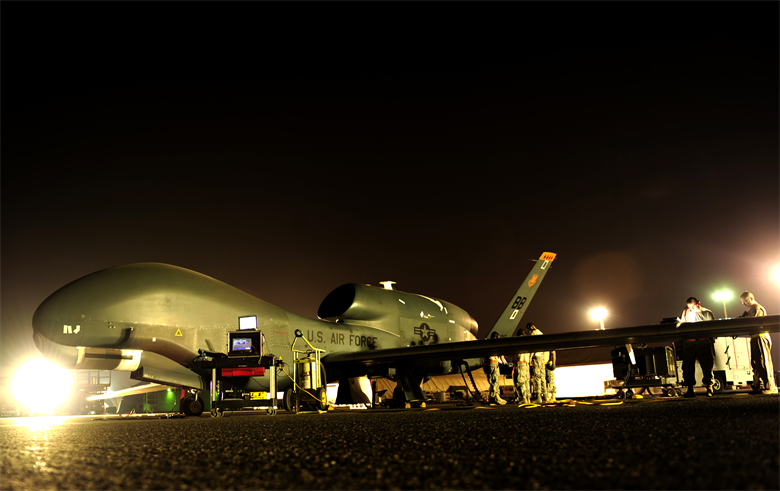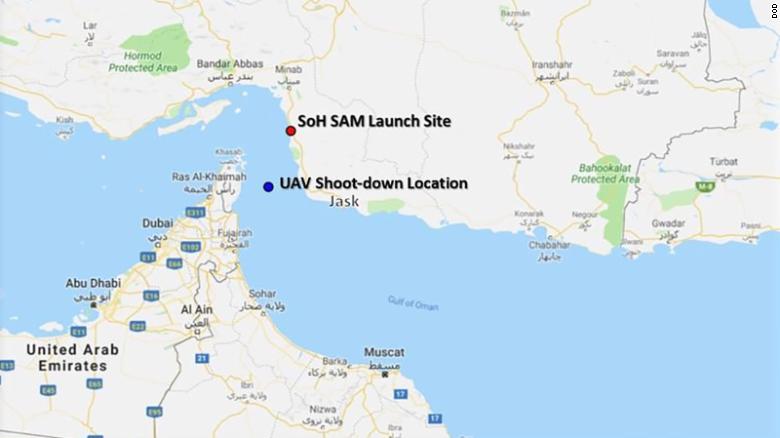
The top news thus far today is that Iran has – and the U.S. Central Command has confirmed – shot down a U.S. surveillance drone that allegedly violated its airspace near the Strait of Hormuz.
The president has just released a short, terse, ominous tweet: “Iran made a very big mistake!”
Added: The Pentagon has released a map showing where they say the aircraft was shot down, over international waters (below).

While the exact nomenclature, version or type of drone – RQ-4 Global Hawk, MQ-4C Triton, Broad Area Maritime Surveillance (BAMS-D) ISR aircraft – is being reported differently, one thing is for sure: At $100 million a pop, this is no ordinary drone.
The following are excerpts from an October 2014 “fact sheet” on the RQ-4 Global Hawk:

An RQ-4 Global Hawk soars through the sky to record intelligence, surveillance and reconnaissance data.
Mission
The RQ-4 Global Hawk is a high-altitude, long-endurance, remotely piloted aircraft with an integrated sensor suite that provides global all-weather, day or night intelligence, surveillance and reconnaissance (ISR) capability. Global Hawk’s mission is to provide a broad spectrum of ISR collection capability to support joint combatant forces in worldwide peacetime, contingency and wartime operations. The Global Hawk provides persistent near-real-time coverage using imagery intelligence (IMINT), signals intelligence (SIGINT) and moving target indicator (MTI) sensors.
Features
Global Hawk is flown by a Launch and Recovery Element (LRE) and a Mission Control Element (MCE). The LRE is located at the aircraft base and functions to launch and recover the aircraft while en route to and from the target area. The MCE controls the Global Hawk for the bulk of the ISR mission. Like the LRE, the MCE is manned by one pilot, but adds a sensor operator to the crew. Command and control data links enable complete dynamic control of the aircraft. The pilot workstations in the MCE and LRE are the control and display interface (cockpit) providing aircraft health and status, sensors status and a means to alter the navigational track of the aircraft. From this station, the pilot also communicates with outside entities to coordinate the mission (air traffic control, airborne controllers, ground controllers, other ISR assets).
The sensor operator workstation provides capability to task the sensor, dynamically update the collection plan in real time, initiate sensor calibration and monitor sensor status. The sensor operator also assists the exploitation node with image quality control, target deck prioritization and scene tracking to ensure fluid operations.
The system offers a wide variety of employment options. The unmatched range and 30+ hour endurance allow tremendous flexibility in meeting mission requirements. In 2014, an RQ-4 Block 40 flew a 34.3 hour flight, setting the endurance record for longest unrefueled flight by a U.S. Air Force aircraft.
Background
The Global Hawk has been deployed operationally to support overseas contingency operations since November 2001.
In the RQ-4 name, the “R” is the Department of Defense designation for reconnaissance and “Q” means unmanned aircraft system. The “4” refers to the series of purpose-built remotely piloted aircraft systems. The “E” in EQ-4 delineates the communication configuration of the BACN equipped aircraft.
The Global Hawk is operated by the 12th Reconnaissance Squadron at Beale Air Force Base, California, and the 348th Reconnaissance Squadron at Grand Forks AFB, North Dakota, but aircraft are rotated to operational detachments worldwide.
General Characteristics
Primary function: high-altitude, long-endurance ISR
Contractor: Northrop Grumman (Prime), Raytheon, L3 Comm
Power Plant: Rolls Royce-North American F137-RR-100 turbofan engine
Thrust: 7,600 pounds
Wingspan: 130.9 feet (39.8 meters)
Length: 47.6 feet (14.5 meters)
Height: 15.3 feet (4.7 meters)
Weight: 14,950 pounds (6,781 kilograms)
Maximum takeoff weight: 32,250 pounds (14628 kilograms)
Fuel Capacity: 17,300 pounds (7847 kilograms)
Payload: 3,000 pounds (1,360 kilograms)
Speed: 310 knots (357 mph)
Range: 12,300 nautical miles
Endurance: more than 34 hours
Ceiling: 60,000 feet (18,288 meters)
Armament: None
Crew (remote): three (LRE pilot, MCE pilot, and sensor operator)
Inventory: active force, 33 (three more Block 30s purchased, to be fielded in 2017)
















